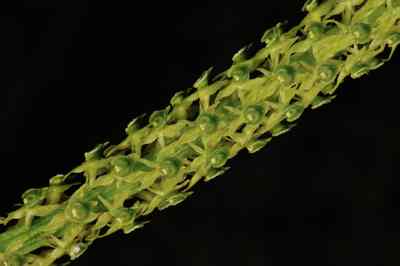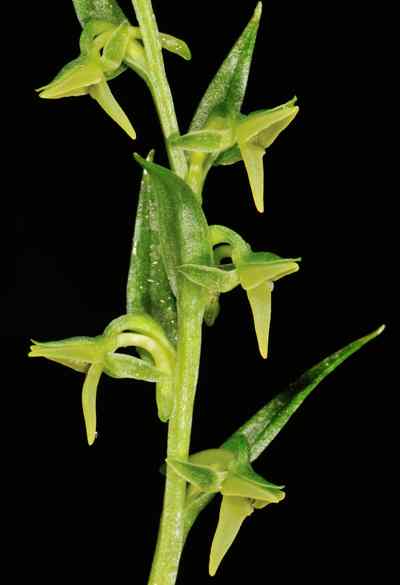The Plant
Terrestrial. Plant of varying height, 7 to 40 cm. Stem arising from the base of an ovoid pseudo-bulb of the previous year, slender, fleshy with a broad ovate long sheath at its base often overlapping with another short one half its lengths. Pseudo-bulb with many fibrous roots from its base and covered with many dried sheaths of the previous year. Stem between one-third and half the height of the whole plant. Leaves two, almost opposite in arrangement, unequal, ovate to oblong, 2 to 5 cm in length and 1 to 3 cm in width, base narrowed to a tubular petiole. Inflorescence terminal, raceme ribbed, flowers small, many, laxly arranged.
The Flower
Flowers non-resupinate. Sepals un-equal, lanceolate with broad base, dorsal pointing downwards, lateral erect and somewhat twisted to its apex. Petals as long as the sepals, much narrowed, oblong and spreading. Lip cordate with broad base, slightly longer than the sepals and petals, fleshy, basal part thickened with side lobes. Floral bract lanceolate, arising from the lower base and as long as the twisted and erect ovary.
Sepals, petals and floral bract yellowish green. Lip dark green with its pointed apex turning yellowish green.


The Pursuit
A species with its presence all over the Himalayas and well-documented. I too spotted it from the compound of my place of stay in the initial days itself. However, a close study of few specimens near to my place of stay made me think about studying the species from a wide range, as many specimens had shown variations. Hence, every other day I studied several specimens I encountered.
In the mean time, I came across an article on “Resupination” in an International journal. The theory mentioned in the article made me eager to know whether any of the specimens of this species behave the same way as mentioned in the article. Even though I observed several hundred specimens in the coming days none of them showed anything related to the theory in the article.
In the third month of the Alpine flowering season, I was busy travelling up and down the hill documenting and studying many species. In between I found time to check this species also for any new theories. One afternoon, as I was walking back to my camp after long hours in the high hills, I observed few specimens of this species growing close together some 5 ft below into the valley side of my trek route. My curiosity made me think of having a close look of those specimens. The slope was almost vertical and any mistake in negotiating the way down would be a disaster. With the help of my guide I maneuvered down the vertical slope and reached the plants. All of them were in bloom. As the flowers were so tiny, it need close and sharp observation to see the differences. As I was not having a proper positioning there it was very difficult to do keen observation and document those flowers. However, I understood those tiny flowers need more keen observation as I found something unusual.
I decided to retire for the day and come back next day with adequate gear to go down the slope and make right understanding of the flowers. Next day, we took a 7-foot long bamboo ladder and a few meters of rope to the location for facilitating the descent. We hung the ladder down the slope by tying it to a nearby Rhododendron tree with ropes. I slowly went down the ladder and standing on its second last step, I studied the flowers using a magnifying glass. To my surprise I found that the flowers of those specimens were resupinate, where as in all others cases the flowers were non-resupinate. There was no limit to my joy, as the new finding is going to re-write history. Even though I was very dangerously positioned, I did all I can do to document the flowers with all its minute details.
This is possibly the only photo documentary evidence of resupinate flowers of this species, thus opening a new dimension in the study of resupination world wide.
Reference:
King, G. & Pantling, R. (1898). The Orchids of the Sikkim-Himalayas. Ann. Roy. Bot. Garden. (Calcutta). Microstylis muscifera Ridley., Page no 20/21.








